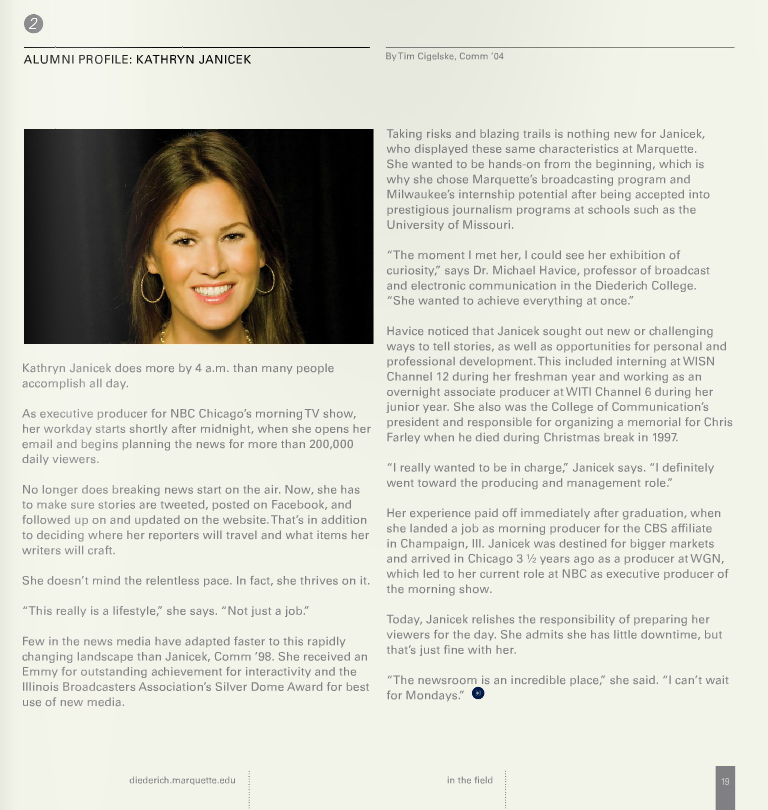Picture courtesy of Marquette University
Is your college in the big dance?
Mine is!
The Marquette Golden Eagles play University of South Carolina Friday, March 17.
While we’re talking about college… I just stumbled upon this on my Mac today.
Tim Cigelske is a Marquette University graduate and teacher. He teaches in the College of Communication.
Here’s a beautiful piece Tim wrote about me in Marquette Magazine a few years ago. Thank you, Tim.
The article was written when I was an executive producer at NBC. Since then, I created my own company. I am now a media coach and a public speaking trainer.
Tim also freelances on the side for some blogs and websites… so if you’re looking for a good writer with an awesome sense of humor… it’s him.
Go Marquette!
ALUMNI PROFILE: KATHRYN JANICEK
By: Tim Cigelske
Kathryn Janicek does more by 4 a.m. than many people accomplish all day.
As executive producer for NBC Chicago’s morning TV show, her workday starts shortly after midnight
, when she opens her email and begins planning the news for more than 200,000 daily viewers.
No longer does breaking news start on the air. Now, she has to make sure stories are tweeted, posted on Facebook, and followed up on and updated on the website. That’s in addition to deciding where her reporters will travel and what items her writers will craft.
She doesn’t mind the relentless pace. In fact, she thrives on it.
“This really is a lifestyle,”she says. “Not just a job.”
Few in the news media have adapted faster to this rapidly changing landscape than Janicek, Comm ’98. She received an Emmy for outstanding achievement for interactivity and the Illinois Broadcasters Association’s Silver Dome Award for best use of new media.
Taking risks and blazing trails is nothing new for Janicek, who displayed these same characteristics at Marquette. She wanted to be hands-on from the beginning, which is why she chose Marquette’s broadcasting program and Milwaukee’s internship potential after being accepted into prestigious journalism programs at schools such as the University of Missouri.
“The moment I met her, I could see her exhibition of curiosity,” says Dr. Michael Havice, professor of broadcast and electronic communication in the Diederich College. “She wanted to achieve everything at once.”
Havice noticed that Janicek sought out new or challenging ways to tell stories, as well as opportunities for personal and professional development. This included interning at WISN Channel 12 during her freshman year and working as an overnight associate producer at WITI Channel 6 during her junior year. She also was the College of Communication’s president and responsible for organizing a memorial for Chris Farley when he died during Christmas break in 1997.
Ï really wanted to be in charge,: Janicek says. “I definitely went toward the producing and management role.”
Her experience paid off immediately after graduation, when she landed a job as a morning producer for the CBS affiliate in Champaign, Ill. Janicek was destined for bigger markets and arrived in Chicago 3 1/2 years ago as a producer at WGN, which led to her current role at NBC as executive producer of the morning show.
Today, Janicek relishes the responsibility of preparing her viewers for the day. She admits she has little downtime, but that’s just fine with her.
“The newsroom is an incredible place,” she said. “I can’t wait for Mondays.”














